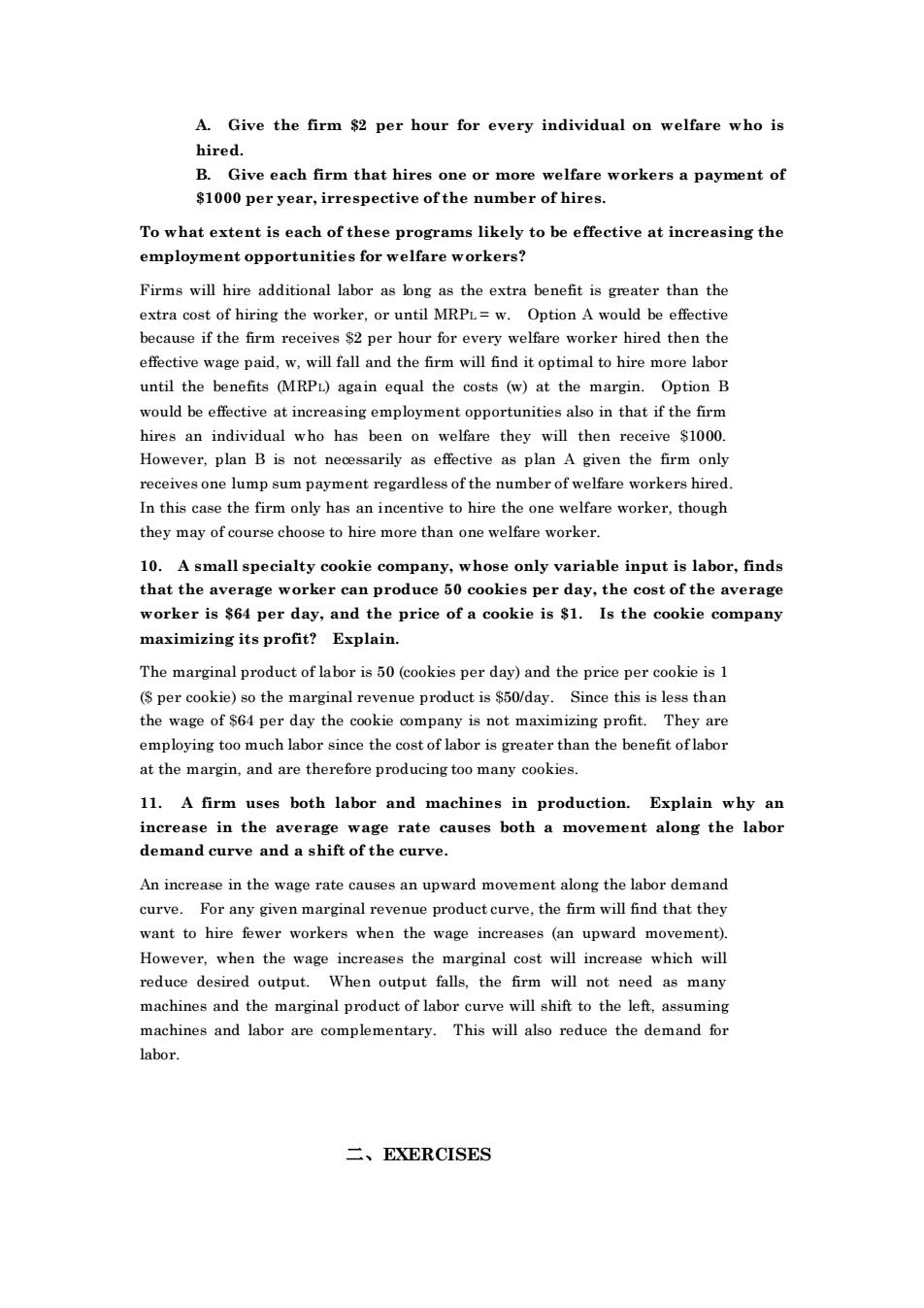正在加载图片...

A.Give the firm $2 per hour for every individual on welfare who is hired. B.Give each firm that hires one or more welfare workers a payment of $1000 per year,irrespective of the number of hires. To what extent is each of these programs likely to be effective at increasing the employment opportunities for welfare workers? Firms will hire additional labor as long as the extra benefit is greater than the extra cost of hiring the worker,or until MRP=w.Option A w use if the recei $2 p er h effective wage paid,w,will fall and the firm will find it optimal to hire more labor until the benefits (MRPL)again equal the costs (w)at the margin.Option B would be effective at increasing employment opportunities also in that if the firm hires an individual who has been on welfare they will then receive $1000 lan Ag时 n the firm receivesone lump sum payment regardless of the number of efare workershire In this case the firm only has an incentive to hire the one welfare worker,though they may of course choose to hire more than one welfare worker. 10.A small specialty cookie company.whose only variable input is labor.finds that the average worker can produce 50 cookies per day,the cost of the average worker is $64 per day,and the price of a cookie is $1.Is the cookie company maximizing its profit? Explain. The marginal product of labor is50(cookies per day)and the price per cookie is (S per cookie)so the marginal revenue product is $50/day.Since this is less than the wage of $64 per day the cookie company is not maximizing profit.They are employing too much labor since the cost of labor is greater than the benefit of labor at the margin,and are therefore producing too many cookies. 11.A firm uses both labor and machines in production.Explain why an increase in the avera e rate causes both a movement along the labor demand curve and a shift of the curve. An increase in the wage rate causes an upward movement along the labor demand curve.For any given marginal revenue product curve.the firm will find that they want to hire fewer workers when the wage increases (an upward movement). output Wher output falls,the firm will no ed as man machines and the marginal product of labor curve will shift to the left,assuming machines and labor are complementary.This will also reduce the demand for labor. 二、EXERCISESA. Give the firm $2 per hour for every individual on welfare who is hired. B. Give each firm that hires one or more welfare workers a payment of $1000 per year, irrespective of the number of hires. To what extent is each of these programs likely to be effective at increasing the employment opportunities for welfare workers? Firms will hire additional labor as long as the extra benefit is greater than the extra cost of hiring the worker, or until MRPL = w. Option A would be effective because if the firm receives $2 per hour for every welfare worker hired then the effective wage paid, w, will fall and the firm will find it optimal to hire more labor until the benefits (MRPL) again equal the costs (w) at the margin. Option B would be effective at increasing employment opportunities also in that if the firm hires an individual who has been on welfare they will then receive $1000. However, plan B is not necessarily as effective as plan A given the firm only receives one lump sum payment regardless of the number of welfare workers hired. In this case the firm only has an incentive to hire the one welfare worker, though they may of course choose to hire more than one welfare worker. 10. A small specialty cookie company, whose only variable input is labor, finds that the average worker can produce 50 cookies per day, the cost of the average worker is $64 per day, and the price of a cookie is $1. Is the cookie company maximizing its profit? Explain. The marginal product of labor is 50 (cookies per day) and the price per cookie is 1 ($ per cookie) so the marginal revenue product is $50/day. Since this is less than the wage of $64 per day the cookie company is not maximizing profit. They are employing too much labor since the cost of labor is greater than the benefit of labor at the margin, and are therefore producing too many cookies. 11. A firm uses both labor and machines in production. Explain why an increase in the average wage rate causes both a movement along the labor demand curve and a shift of the curve. An increase in the wage rate causes an upward movement along the labor demand curve. For any given marginal revenue product curve, the firm will find that they want to hire fewer workers when the wage increases (an upward movement). However, when the wage increases the marginal cost will increase which will reduce desired output. When output falls, the firm will not need as many machines and the marginal product of labor curve will shift to the left, assuming machines and labor are complementary. This will also reduce the demand for labor. 二、EXERCISES